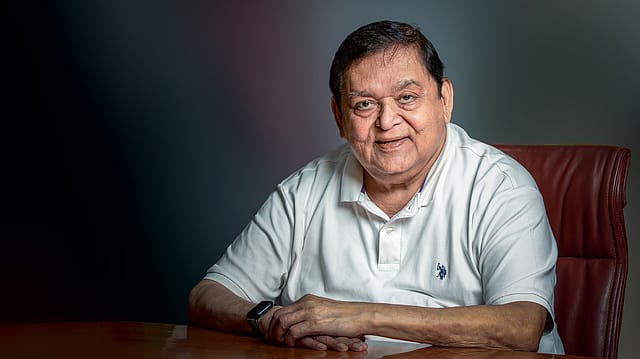The Nation Builder At L&T

“WHILE CREATING VALUE for our shareholders, we never lost sight of our overarching goal — we are here to serve the nation,” says A.M. Naik, the 80-year-old, who stepped down as group chairman of L&T on September 30. Naik, who wears the Indian national flag on his chest on most occasions, has also designed a golden flag with L&T’s logo in the middle, which he proudly displays in the middle of two national flags at the company’s select office conference rooms in Mumbai and other L&T offices.
Naik takes pride in the national assets L&T made or continues to make —stadiums, refineries, airports, metros, bullet train, marquee buildings, space and nuclear programmes, defence and shipyards. He was awarded the Padma Bhushan in 2009 and the Padma Vibhushan in 2019.
“I never took leave. I worked even on Sundays and about 16 hours every day,” Naik tells Fortune India at his colonial bungalow, High Trees, in Mumbai’s Pali Hill area.
Naik joined Larsen & Toubro in 1965 as a junior engineer with a salary of ₹650 a month, became its CEO in 1999, and chairman and MD in 2003. Even his critics agree that Naik built a large part of the L&T of today — from just ₹6,883 crore in net sales in 1998-99 to ₹1.83 lakh crore in 2022-23. Market capitalisation grew from ₹5,815 crore to ₹3.04 lakh crore during the period. The company has entered all possible business adjacencies, many from scratch, while selling off 16 non-core businesses. L&T, which was in over 80 businesses at one time, now operates as 9-10 ‘independent companies’, as Naik fondly says.
Sipping his favourite cold coffee in a casual white T-shirt and black trouser, Naik confronts a key question — what does he regret not doing? “I wish we had got into power development a decade earlier; we also got late into IT and nearly missed the bus.” He adds that he could have accomplished more, had the Indian economy opened up much earlier. But then, it is pointless to think so now. “There is no point in such kind of idle speculation. I avoid thinking about the past and musing on what might have been”.
Other than the reputation and huge engineering behemoth he created, Naik’s current and former employees also credit him for protecting L&T twice from hostile acquisitions by two big corporate groups in the early 2000s. “My successor will not have to face the challenges that I had to overcome,” says Naik.
However, in hindsight, the second takeover attempt was a win-win situation for all, he adds. The conglomerate behind the takeover attempt obtained what it was looking for — the cement business, which L&T was planning to exit anyway, says Naik. It also led to the formation of the L&T Employees Trust, which now owns 14% of the company, and by virtue of being the single-largest shareholder has ring fenced L&T against takeover attempts to a great extent. The engineering major eventually created millionaires out of a number of employees — a single share worth ₹33 around 20 years ago is now equivalent to ₹2,919.
Colleagues, past and present, see Naik as an aggressive professional and a demanding boss. It stems from his humble background and rise through the ranks. Naik completed his education from a tribal school in Gujarat and studied engineering at Anand Birla Vishvakarma Mahavidyalaya. He came to Bombay with big dreams, bagged the job at L&T, made his mark as an engineer, worked hard to earn five promotions, and become an assistant general manager within five years.
Though L&T might evolve further, it will not deviate much from the platforms already created for growth, says Naik. Green energy, which will include green hydrogen, electrolysers and batteries, and three new digital businesses — e-trading platform L&T Sufin, L&T Edutech and L&T Data Centres & Cloud business — are all targeting a new future. “In green hydrogen, L&T and its partners will invest over $4 billion in three-five years,” says Naik. Currently, 33% of L&T’s business comes from global markets, almost nil when he took over.
Naik may be retiring from top management, but his association with the company, which he calls a ‘temple’, will continue. He will remain chairman of the L&T Employees Trust. The company also follows a seven-step leadership programme, which ends with mentoring by Naik. Most of the board members have gone through the process. “I will continue to mentor and build a leadership pipeline for L&T that will extend to 2040,” says Naik.
For legacy, A biography on Naik, The Nationalist (written by Minhaz Merchant), was followed by the Shapers of Business Institutions in 2020. A third book is in the works.
Naik has pledged most of his wealth to charity and runs educational institutions and healthcare facilities under two trusts. The Nirali Memorial Medical Trust, in the name of his granddaughter who died of cancer at the age of two, runs five hospitals, including a cancer-care facility at his village Navsari, an ophthalmology hospital at Surat, and a radiation centre, general hospitals and a large healthcare facility in Powai, Mumbai. The Naik Charitable Trust runs schools in villages around Endhal and Kharel in Gujarat and has adopted around 40 schools across four blocks in Navsari.
Naik is now developing a large technical training system for school dropouts at his Anil Naik Technical Training Centre in Gujarat. His son, who has returned from the U.S. after 29 years, currently oversees the functioning of the trusts. Post September 30, Naik wants to devote more time to running them.
If his track record in the corporate world is anything to go by, the world of philanthropy has much to celebrate.